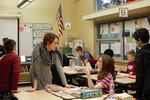New research released Tuesday shows students are struggling with distance learning during the coronavirus pandemic, even as many Oregon students are continuing school from home this fall.
That includes students like Osvaldo. Back in the spring, he thought he was doing well. But at a meeting with his teachers a few weeks into distance learning, his mom Andrea heard otherwise.
“His teachers were like, ‘he’s not completing the work’ - so then we started looking...and it was him trying to catch up, but also a motivational thing too,” Andrea said.

Class of 2025 student Osvaldo and his mom Andrea at their home in September.
Elizabeth Miller
Osvaldo is part of the “Class Of 2025,” a group of students OPB has followed for the last eight years. By spring 2020, the students were most of the way through 7th grade, most of them at Ron Russell Middle School in Southeast Portland.
Then the COVID-19 threat came to Oregon. Schools were ordered to close beginning March 16.
For most of the Class of 2025, they haven’t been back to school since. They’ve been learning at home, and like students and teachers across the country, they’ve had to learn how to do school and communicate in a brand new way.
Home became school for students like Anais and she didn’t like it.
“Usually when you’re at home, you feel like you’re at home...you don’t feel like you have to do that much work, you feel comfortable,” she said.
“Over at school, you have to do work, and... it’s overwhelming.”
Osvaldo and Anais’ schools weren’t able to offer live instruction in the spring, which left both students and teachers feeling disconnected. Some students weren’t completing their work.
Related: Oregon voters pass 15 out of 18 school-related measures statewide
This fall, there is live instruction, and just a few days into the new year, Osvaldo said he was feeling pretty good.
“I’m already getting used to it, like I’ve been doing it for a long time,” he said.
At the same time, there’s a global pandemic preoccupying students.
Some students, like Leyna, have parents that have to leave home for work. Her mom works in a hospital.
“Sometimes I get scared for her and her health,” Leyna said. “I don’t want her to get sick because she’s in a hospital, there’s a lot of sick patients. But I know that she knows how to handle stuff, because she’s our mom.”
These distractions and difficulties show up in new data from NWEA, a Portland company responsible for the MAP Growth test, a math and reading assessment taken by millions of students all over the country.

Ron Russell Language arts teacher Sadie Kenzler with Class Of 2025 student Ava in December 2019. The school is in comprehensive distance learning at least through January, which means interactions like these happen over a screen rather than in-person.
Elizabeth Miller
NWEA looked at more than four million students’ test results in grades 3-8 between last year and this fall. Researchers found reading scores hadn’t changed, but math scores were five to ten percentage points lower compared to students in the same grade last year.
NWEA researchers call it “unfinished learning” - kids are learning new things, just not as quickly as they were in person.
“These findings suggest continued gains in reading [and] unfinished learning in math,” said NWEA researcher Megan Kuhfeld.
And while reading lessons might be repeated over time, math is sequential, building upon what students were expected to learn in previous grades.
So that “unfinished learning” in the spring could create a lasting effect beyond this year.
“The challenge around mathematics is an acute one, and it’s something we’re going to be dealing with even after we get back in school,” NWEA CEO Chris Minnich said. “Once we get back in school, it’ll be easier to remediate, probably, but this is something we as a country could really focus on and make some gains in.”
NWEA recommends continued funding to school districts from both state and federal sources, as well as transparent data to accurately show where students are struggling and where resources may be most needed.
The preliminary data from NWEA show that students scored better than expected in reading, and about the same or better in math, compared to NWEA’s learning loss projections in the spring. But the reported figures could be understating the learning loss.
NWEA says hundreds of thousands of students aren’t in the data at all - they’re missing.
“Twenty-five percent of the students in the schools that consistently tested between last year and this year are no longer showing up,” Kuhfeld said. “Almost one in four.”
She said they could have opted out, or might’ve been absent. But there’s no way of knowing, and it means the data are not tracking the progress, or lack of it, for many students during 2020.
Class of 2025 student Kaylie might be an example of someone who wanted to be “in school” last spring, but couldn’t. Like millions of students around the country, Kaylie didn’t have an internet connection at home.
“We were trying to get the internet, but so many people were trying to get it,” Kaylie said. “We got it too late.”
According to NWEA, the students missing from their data include students who are ethnic or racial minorities, students with lower achievement and students in schools with “higher concentrations of socio-economically-disadvantaged students.”
Kuhfeld said there are some students who typically don’t show up in testing data one year to the next, but the 25% number is much higher.
“Given we’ve also seen school district reports of higher levels of absenteeism in many different school districts, I think that this is something to really be concerned about,” Kuhfeld said.
Assessing students as school leaders have in the past may prove difficult going forward, as state leaders consider a pause on federal assessment requirements and the National Assessment of Educational Progress is postponed.
“The change in operations and lack of access to students to be assessed means that NAEP will not be able to produce estimates of what students know and can do that would be comparable to either past or future national or state estimates,” said James Woodworth, Commissioner of the National Center for Education Statistics, in a statement dated last Wednesday.

A crowded hallway at Ron Russell Middle School in between classes in December 2019.
Elizabeth Miller, Elizabeth Miller / OPB
But this school year may also exacerbate historic disparities between students based on race. A national survey from Chalkbeat and The Associated Press shows students of color are more likely than white students to start the year online. Oregon has long had significant achievement gaps based on race and income.
It’s a disparity Michael Contreras sees firsthand, as principal of Ron Russell Middle School, where in 2018-2019, students of color were nearly double the share of white students. School there will be online at least through January.
“When they all come to the building, at least there’s some equity around, we are all walking in the same space,” Contreras said. “When they’re at their homes, they’re in different spaces. So trying to support that is just way tougher.”
